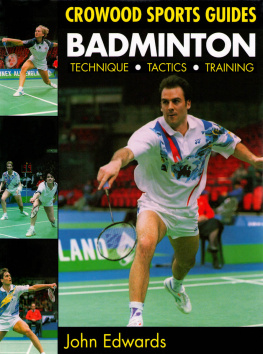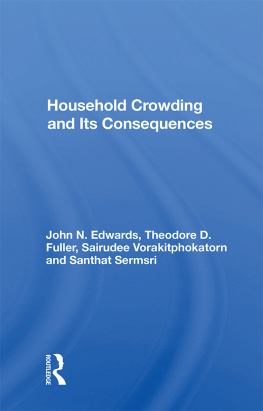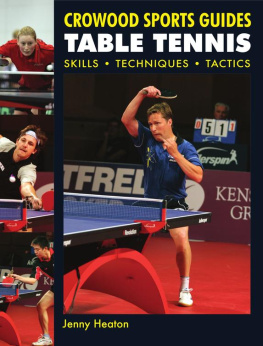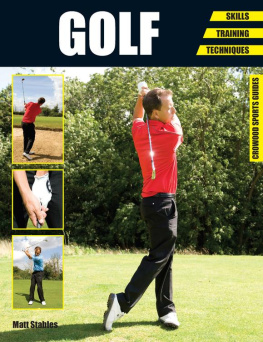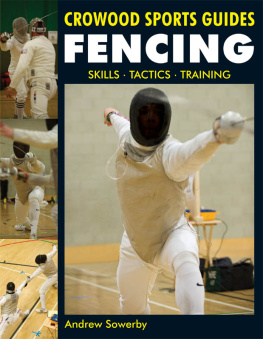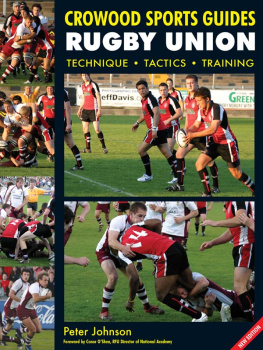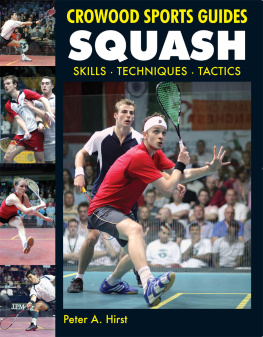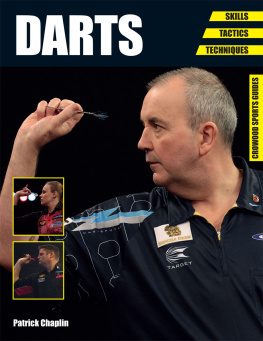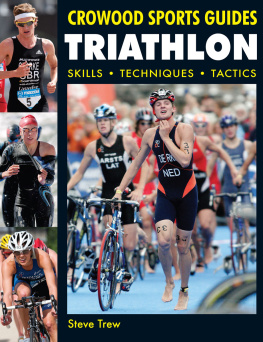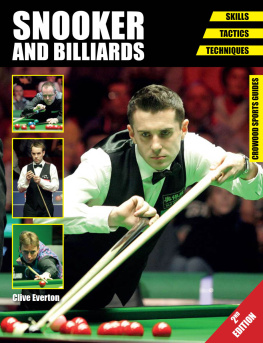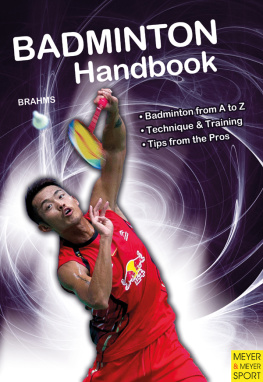CROWOOD SPORTS GUIDES
BADMINTON
TECHNIQUE TACTICS TRAINING
John Edwards

The Crowood Press
Acknowledgements
The author and publishers would like to thank the following for their help in the production of this book: Stephen Line (for photographs); The Badminton Association of England (for the use of their courts); Alison Drage, Miles Green, Ian Stockford, Rachel Harrison (Northamptonshire Juniors) and Clive Ellames (Director of Development, Badminton Association of England).
Dedication
To my wife Jennie, with grateful thanks for her patience and consideration during the production of this book.
First published in 1997 by
The Crowood Press Ltd
Ramsbury, Marlborough
Wiltshire SN8 2HR
www.crowood.com
This e-book first published in 2014
This impression 2008
The Crowood Press Ltd 1997
All rights reserved. No part of this publication may be reproduced or transmitted in any form or by any means, electronic or mechanical, including photocopy, recording, or any information storage and retrieval system, without permission in writing from the publishers.
British Library Cataloguing-in-Publication Data
A catalogue record for this book is available from the British Library.
ISBN 978 1 84797 854 7
Note: In March 2005 the Badminton Association of England was rebranded as BADMINTON England.
Unless specific reference is made within the book, the pronouns he, him and his are used in contexts intended to apply to both male and female players.
It has been assumed that the reader is a right-handed player.
CONTENTS
PREFACE
Badminton is easy to play a bold statement but one that is true. All you need is the ability to hit upwards and downwards and you have the components of a simple rally!
The game has many attractions. It can be enjoyed by all ages, as an individual or as a part of a team or family, courts are usually available in most places, and whether you have ample spare time or little to spare you can set your own commitment levels and play socially or competitively. Add to this that the singles game differs greatly from the doubles game and you have the ingredients of a sport that is easy to learn, fascinating and infectious.
Its exact origins are unknown and accounts do vary. However, it is played all over the world and has been in existence for many decades. Many believe that a crude form of the game was first played at Badminton, the Gloucestershire estate of the Duke of Beaufort, in the 1860s. Others claim that it was first played in India. The first organized body for the sport was the Badminton Association of England, formed in 1934.
Throughout Britain, the game is enjoyed by a some five million people, who play in a variety of venues. Though some courts remain in church and village halls, the majority of players gain their enjoyment using the leisure centres that have become so prolific.
Badminton is an interesting challenge for both the newcomer to the game and the seasoned player. The starting point is to master the techniques required to move around the court and strike the shuttle. In tandem with this you will need to find ways to out-think your opponents, exploit weaknesses, play to your strengths and apply psychology. You may develop a particular flair for singles, level or mixed doubles or become a player who is fortunate enough to be equally at home in all three and you will never stop learning.
The aim of this book is to improve your performance and understanding of this great game. Whether you are a newcomer, established player or coach, I hope that the contents stimulate thought and contribute to your enjoyment of the sport.

CHAPTER 1
THE LAWS OF THE GAME
Players should familiarize themselves with the complete laws of badminton. These are agreed and adopted by the Badminton World Federation (BWF) and are available in booklet form from BADMINTON England. They can also be downloaded. This chapter contains a simplified summary of how to score for those who are new to the game. Badminton can be played by two (Singles) or four (Doubles) players. The aim is hit the shuttlecock (more usually referred to as the shuttle) over the net and into play in such a manner that it hits the ground inside the opponents court before they can reach it.
There are five disciplines in badminton: Ladies and Mens Singles, Ladies and Mens Doubles and Mixed Doubles. There are several methods of scoring. Players could even create their own version, but in the following paragraphs the focus will be on the main system in use today within most clubs, and all national and international matches. This format is called Rally Points and the system was adopted by the BWF in May 2010.
Matches are the best of three games to 21 points. Establish who is to serve by either tossing a coin or throwing a shuttle in the air. On landing, if the shuttle base faces more towards your side of the net it is you who can choose to either: serve, receive serve or select a particular end of the court. Your opponent then chooses one of the two remaining options and the game can begin.
Scoring in Ladies and Mens Singles
The court area for Singles is long and thin. Therefore the side tramlines are not used at any point in the game.
Every rally is worth 1 point. Hence if you serve out of court or into the net, your opponent wins a point. When the serve is zero or an even number Player A (the server) will stand in the right-hand service court and Player B (the receiver) in the diagonally opposite box. If Player A wins the rally a point is gained and the score becomes 10. Player A continues to have the right to serve and delivers his next serve from the left-hand service court. However if Player A loses the first rally the right to serve passes to Player B, who gains a point and will deliver his serve from the left-hand service court because his score is an odd number. It is advisable to call out the score as the game develops, calling the servers score first. Remember that when the score is an even number the server delivers from the right-hand service court, and when odd from the left.
Should the score reach 2020, play continues until one player has two clear points. If 2929 is reached the winner shall be the player who wins the next rally.
In game two the player who won the first game starts at 00 from the right--hand court.
Should the match go to a third game, players change ends when one player reaches 11 points.
Scoring in Ladies Doubles, Mens Doubles and Mixed Doubles
The court area for Doubles differs from Singles. For serving in Doubles, the side tramlines are in but the rearcourt area is out. Once the serve has been delivered all areas of the court are in.
As is the case in Singles, a Doubles match consists of the best of three games to 21 points. In the Doubles game a team or pair has only one service. We will use the example of a match between Players A & B (who won the toss) versus Players C & D. The server is Player A and the receiver Player C. Hence, as the score is even, Player A serves from the right-hand court to Player C, who must stand to receive in the diagonally opposite service court. If team A/B wins the opening rally, the score becomes 10 and Player A then serves from the left service court. Should the opening rally be won by team C/D, the right to serve passes to them and Player D would serve from the left-hand service court; the receiver would be Player B. Remember that a side has only one server and his start position is governed by the score, i.e. even from the right, odd from the left. Once a team loses the rally, the right to serve passes to the other team and the player who becomes the server would have previously been the servers partner. Obviously once a service is delivered, all players may travel to any part of the court.

